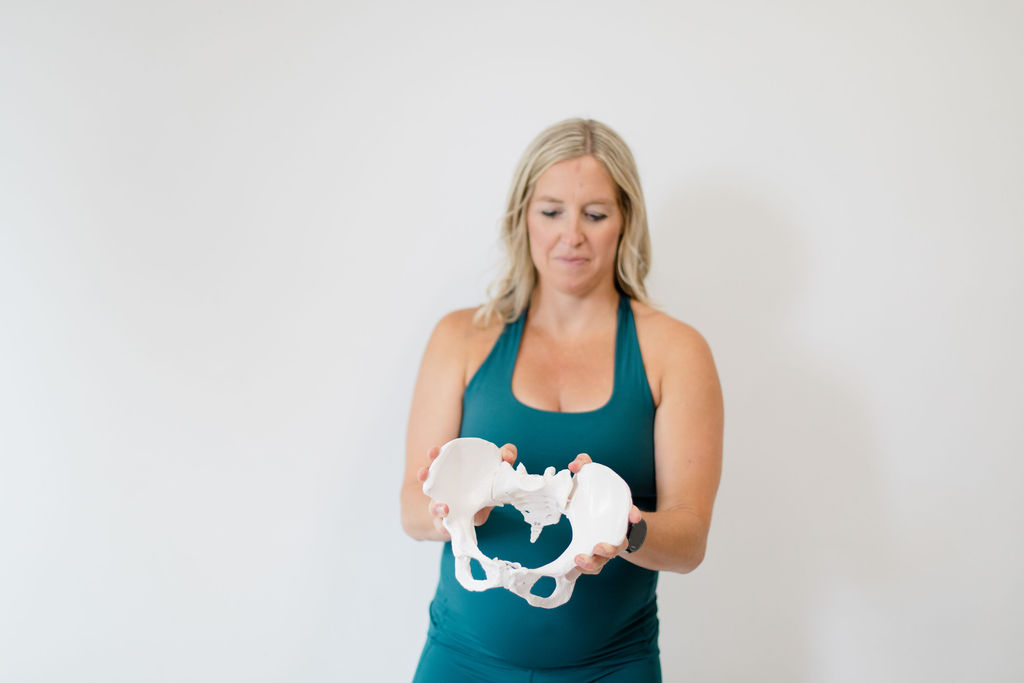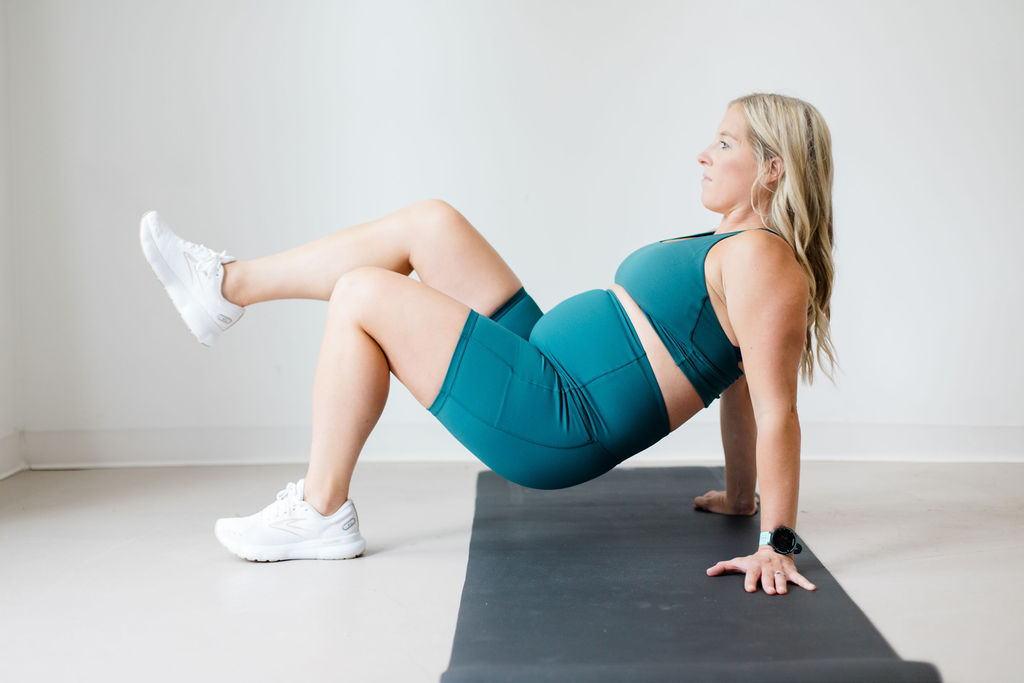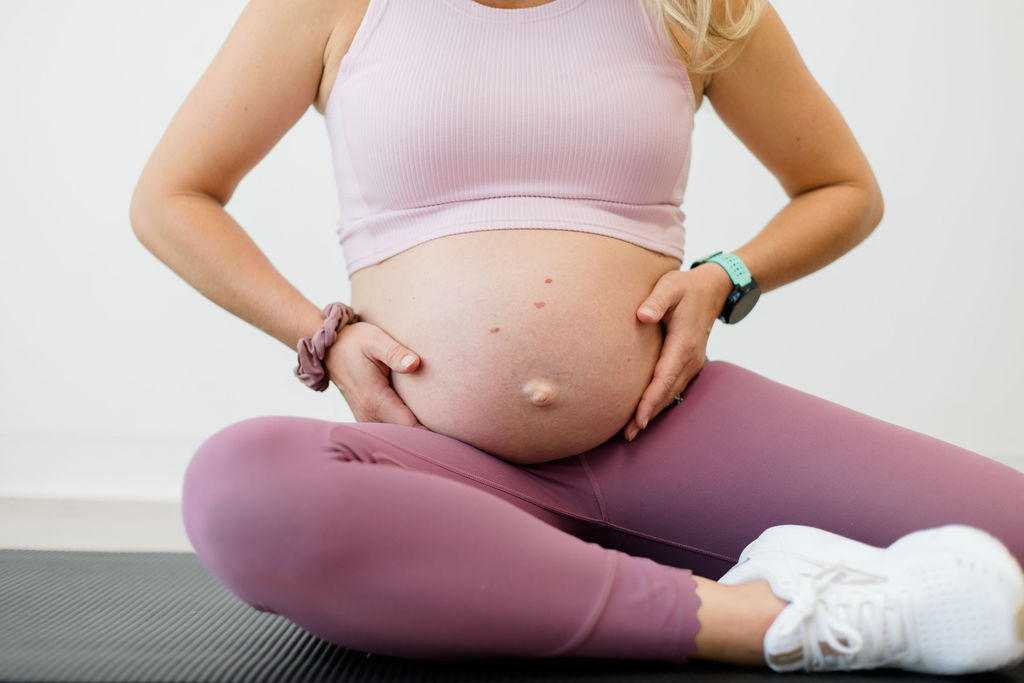Many women experience pelvic pain during pregnancy, but it doesn’t mean that you have to suffer through it. There are effective ways to manage and relieve pelvic pain, and physical therapy is a key part of a healthy pregnancy. In this article, you’ll learn how to relieve pelvic pain during pregnancy.
👋 Hi, I’m Dr. Anna Towne! I’m a Pelvic Floor Physical Therapist, and I experienced miserable “lighting crotch” pain during my first pregnancy. I didn’t know how to relieve it because I hadn’t specialized in Women’s Health yet. But my second and third pregnancies were a different story!
I used the education and exercises in my Strong Expecting Mama Program and could not only prevent pain but also stay active and keep running until 38 weeks!
Pelvic Pain During Pregnancy Symptoms
Roughly 1 in 5 pregnant women experience pelvic pain during pregnancy. It can manifest in a few different ways, including:
- A sharp, shooting pain in the pelvic region (“lightning crotch”)
- A dull, aching pain around the pubic bone
- Pain in the lower back, hips, and thighs
- Discomfort or pain when walking, climbing stairs, or turning over in bed
- A feeling of pressure or heaviness in the pelvic floor
One of the biggest pregnancy myths is that it HAS to be painful. It’s not true. Chronic pain in pregnancy typically develops because of poor pelvic alignment or muscle imbalance, and exercises can help you reduce and even eliminate pain. I see this happen with my mama clients all the time!
If you’re experiencing pelvic pain, strengthening your core and pelvic floor not only helps you alleviate discomfort but also builds a strong foundation for labor and a smooth postpartum recovery.

Types of Pelvic Pain During Pregnancy
Pelvic pain in pregnancy looks a little different for every mama, but it can be generally categorized into the following types:
- Symphysis Pubis Dysfunction (SPD): Pain in the front of the pelvis, around the pubic bone. Can cause significant discomfort and affect mobility. This is often referred to as the “lighting crotch” or pelvic girdle pain. I developed SPD at 13 weeks pregnant with my first, and it was absolutely miserable! It can hurt to walk and stand on one leg or to open up legs to get out of the car.
- Sacroiliac Joint Pain (SI Joint Pain): Pain in the lower back and buttocks, which can often radiate down the legs. Can make standing or walking for extended periods difficult.
- Round Ligament Pain: Sharp and sudden pain in the lower abdomen or groin area. Caused by the stretching of the round ligaments that support the uterus.
The pain can get worse with certain activities, such as walking, going up and down the stairs, or standing on one leg. If you don’t address pelvic pain, it can get worse as the pregnancy progresses. It surprises many moms, but pelvic pain can also persist postpartum.
❗Don’t accept pelvic pain during pregnancy as normal! Following an evidence-based program can help you enjoy your pregnancy pain-free, have a better labor experience, and recover faster postpartum.
What Causes Pelvic Pain During Pregnancy
Pelvic pain during pregnancy usually develops because of a combination of different factors. There’s no one single cause, but common reasons include:
- Hormonal Changes: Your body produces relaxin, a hormone that loosens ligaments and pelvic joints to prepare for childbirth. This hypermobility means that you need more strength to manage the instability in the pelvis!
- Weight Gain: As your baby grows, it puts additional pressure on the pelvis, causing discomfort and pain. Remember that it’s normal – and necessary – for your body to gain weight during pregnancy!
- Postural Changes: Your posture changes during pregnancy to accommodate the growing belly, and if you’re not mindful about staying consistently in good alignment, you can strain the pelvic and lower back muscles.
- Previous Pelvic Injuries: If you had pelvic floor trauma or back injuries before, you may experience worse pain during pregnancy.
💪Keep in mind that if you experienced pain during a previous pregnancy, it does NOT mean that you have to accept it as normal in your future pregnancies.
Subsequent pregnancy symptoms can develop sooner, but they CAN be prevented with the right knowledge and tools! I work with moms all the time who have LESS pain with subsequent pregnancies because they stick with a healthy core and pelvic floor regimen.

How to Relieve Pelvic Pain in Pregnancy
You need two things to relieve pelvic pain during pregnancy: education and exercise.
It’s important to understand how your body works during pregnancy. Posture, breathing, and proper contraction are all affected, but you can correct them to find pain relief and feel your best.
Incorporating the right exercises into your routine can help you:
- Maintain good posture
- Correct your breathing
- Support proper muscle group contraction
- Keep your pelvic floor strong
- Safely keep your deep core strong in pregnancy
- Alleviate pregnancy pain
- Eliminate pelvic floor symptoms, such as leaking
- Heal diastasis recti
- Prepare your body and mind for labor
- Build a healthy postpartum foundation
A physical therapist can provide exercises and treatments to help you stay active throughout your pregnancy without putting extra strain on your changing body. But for most mamas, it’s much easier to use online resources.
🤰This is why I created my program Strong Expecting Mama!
As a physical therapist who helped hundreds of women minimize pain, prep for labor, and strengthen the correct muscles for easier postpartum recovery, I saw that more mamas needed access to high-quality, evidence-based tools and knowledge.
The program is completely online, and I regularly pop into the community to answer questions! You’ll also get weekly updates with little tips and nuggets of information.
→ Get an idea of what you can expect from Strong Expecting Mama with these FREE exercises!
How to Relieve Pelvic Pain During Pregnancy at Night
Nighttime can be particularly challenging for managing pelvic pain. Implementing the right tools and forms of movement during the day should help with nighttime pain, but you can also try:
- Using a pregnancy pillow/sleeping with a pillow between your knees to keep your pelvis in neutral alignment
- Sleeping on your left side (to improve circulation and reduce pressure)
- Practicing diaphragmatic breathing and relaxation exercises
- Sleeping on a firmer mattress
Some women also find that seeing a chiropractor and using a pelvic support belt helps with discomfort.
Pelvic support garments can be HIGHLY effective! Once I found the pelvic support garment I liked, I could be on my feet for WAY longer with dramatically less pain. So many of my clients say that they wish they’d discovered pelvic support garments earlier in their pregnancy. Browse my favorite ones!
Labor and Birth with Pelvic Pain
Most women with pelvic pain go on to have a normal birth. Inform your healthcare provider about your pelvic pain and talk to them about your birth plan.
Certain labor positions, such as kneeling or being on your hands and knees, can reduce pelvic pain. Using a birthing ball can help. But the most helpful thing you can do is prepare your body for labor by doing women’s health physical therapy. Focus on perineal massage and pelvic floor relaxation exercises!
You can find my best labor tips in the Strong Expecting Mama.
FAQs
When Should I Be Concerned About Pelvic Pain During Pregnancy?
Pelvic pain is common during pregnancy, but it doesn’t have to be your new normal. If you experience severe pain that doesn’t improve with rest, bleeding, fluid leakage, fever, or difficulty walking, get in touch with your healthcare provider. Pelvic pain is a sure sign that your pelvic floor needs more support.
What Should I Do If I Can Barely Walk Due to Pelvic Pain During Pregnancy?
Pelvic pain during pregnancy can feel awful. I’m speaking from personal experience! With my first pregnancy, I developed a “lightning crotch” at 13 weeks and struggled with it for the rest of my pregnancy. If you’re finding it hard to keep up with your daily activities because of pelvic pain, it’s essential to start strengthening your core and pelvic floor with evidence-based exercises. This does NOT have to be your pregnancy experience. Seek support from a physical therapist, try my Strong Expecting Mama Program, and use my favorite support garments!
Can You Ice Your Pelvic When Pregnant?
You can, but keep in mind that icing your pelvis when pregnant doesn’t actually solve the root cause of your pelvic pain. It can provide temporary pain relief, but it’s essential to restore proper alignment in your body by strengthening the correct muscles.
Is Walking Good for Pregnancy Pelvic Pain?
For some women, walking can help manage pelvic pain during pregnancy, but for others, it can actually make it worse. Other helpful non-impact options are swimming and stationary biking. Any form of non-weight-bearing movement is typically helpful, and the worst thing to do is “just rest” because being sedentary makes you weaker and increases pain. But keep in mind that movement helps only when combined with proper posture, breathing, and muscle contractions. By itself, it won’t solve pregnancy pelvic pain.
What Is the Throbbing Pain in the Pelvic Area During Pregnancy?
Throbbing pain in the pubic area during pregnancy is often called Symphysis Pubis Dysfunction (SPD) or the “lightning crotch.” It can be very painful, but you don’t have to accept it as a part of your pregnancy. Strengthening your core and pelvic floor, aligning your pelvis, and support garments help you alleviate the throbbing pain.
Does Pelvic Pain Mean Labor Is Near?
Not necessarily. In the later stages of pregnancy, pelvic pain can sometimes indicate that the body is preparing for labor. Make sure to check with your healthcare provider if this is the case. That said, more often than not, it’s a sign that you need to learn pain management strategies and exercises to feel better.
How Long Does Pubic Pain Last in Pregnancy?
Without proper treatment, pelvic pain can start as early as 13-14 weeks and continue up until delivery. For some women, it can also persist postpartum. You don’t have to accept pelvic pain as a normal part of pregnancy. With the right knowledge and safe exercises, it IS possible to eliminate pelvic pain and have a comfortable pregnancy!
Pregnancy Doesn’t Have to Be Painful!
Pregnancy causes dramatic physiological changes in your body. You can minimize the symptoms and pain associated with those changes with my Strong Expecting Mama Program. The education and exercises you’ll learn inside will also promote a healthy delivery and smooth postpartum recovery. Learn more and start your FREE 3-day trial!
